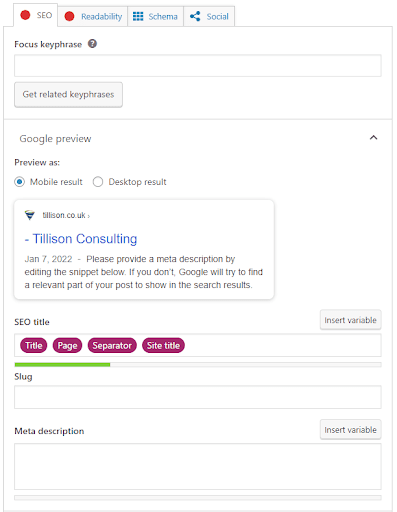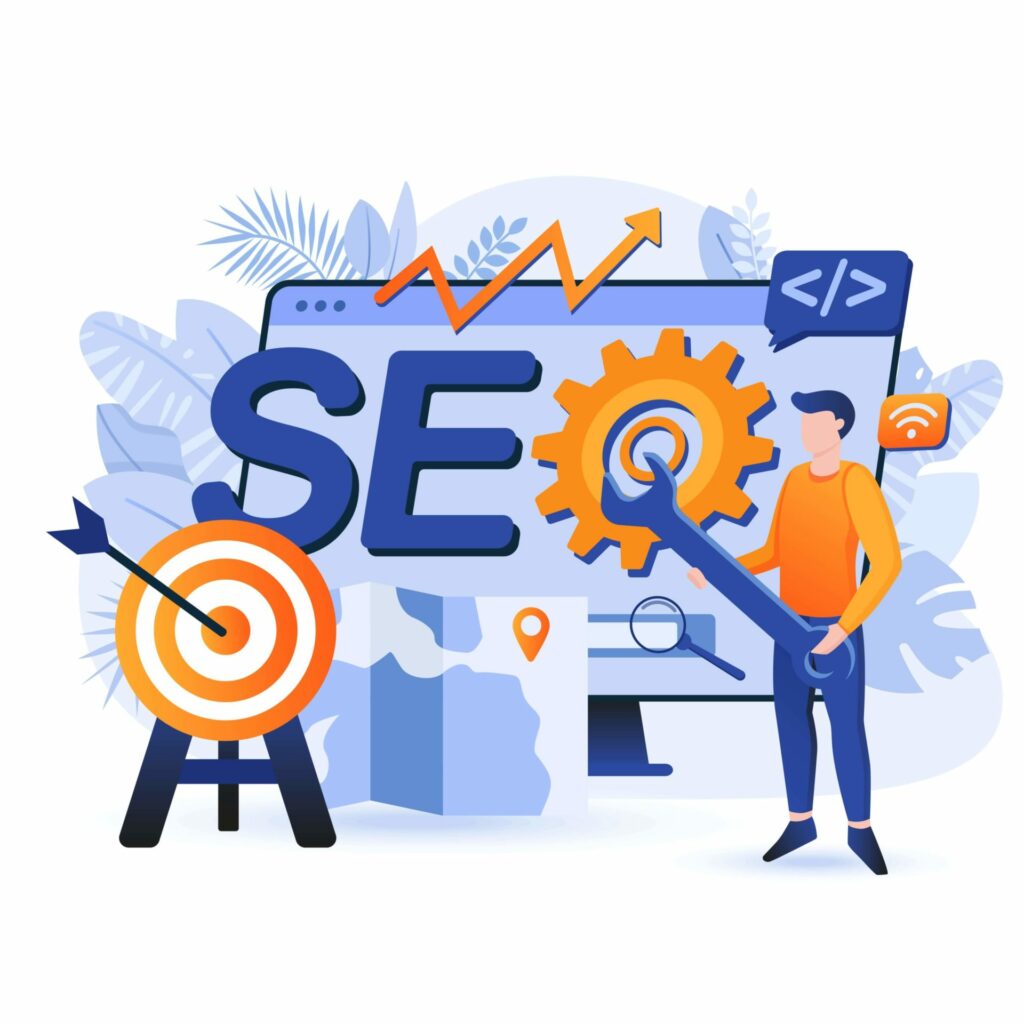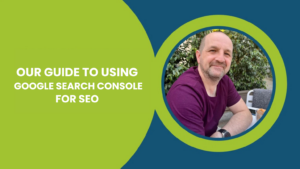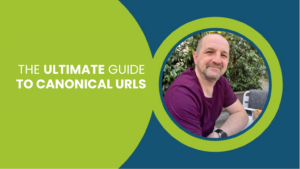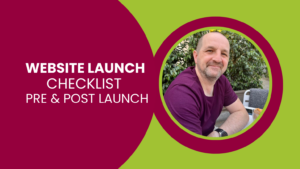The world of search engine optimisation (SEO) can be a frightful place. The sheer amount of jargon and acronyms, this means of digital marketing can be daunting.. Fear not, this glossary is here to define the top SEO terms that you may come across.
What is SEO?
This is a type of marketing that aims to increase the quality and quantity of traffic going to a website by increasing its rank in the search engine results.
Numbers
301 redirect
A 301 redirect is an HTTP status code that means a page has been permanently moved. This code tells the search engine that you have permanently moved a page and where it would like to send the user now. For example, sending the user to a related product page for a discontinued range.
302 redirect
A 302 redirect is an HTTP status code that means a page has been temporarily moved. Use would use this mostly when you are doing maintenance on that page or the product is temporarily out of stock.
404 error
A 404 error means the page could not be found. This would occur when content or a webpage has been moved and the link has not been updated. Error 404s are usually fixed with a 301 redirect to a relevant page.
A B C D E F G H I J K L M N O P Q R S T U V W X Y Z
A
Algorithm
An algorithm is a complex computer program that tells search engines to collect data and information and deliver search results to the user. A mixture of different algorithms are used to rank websites in the search engine rankings and lower the rankings of irrelevant or spammy content. Algorithms are updated and changed regularly to improve the user’s experience.
Alt tag
Also known as the ‘alt attribute’, the alt tag is used in HTML code to describe the appearance and description of a picture on a website. The alt tag should be as detailed as possible. For example, instead of ‘man walk dog’ you should say ‘man wearing red tracksuit walking brown dog’. This helps search engines understand what is happening in the image.
Ahrefs
Ahrefs is an SEO platform used for analysing a website’s SEO health, keywords and links.
Anchor text
Anchor text is text on a page that is hyperlinked or another page, PDF or online media. Anchor text is used as an indicator of the content on the target page by both search engine crawlers and users, so it’s important that it’s descriptive instead of being phrases like ‘click here’ and ‘read more’.
Anchor text is also a key part of internal linking, which helps users navigate your website and crawlers to understand its hierarchy. For more information see internal linking.

Authority
Authority is a quantitative measure that strengthens the visibility of a website in search results. It’s built from high-quality links pointing to and from your website on other domains.
Analytics
Analytics is a way to collect data about your own website so you can analyse what areas are performing well and where you need to improve. Most analytics platforms, like Google Analytics, Semrush and Ahrefs, will show you how many users are on your site, how many actions took place and how many left without doing anything.
B
Bounce Rate
Bounce rate is an analytical metric used to describe the number of users that land on your website and immediately leave without visiting any other pages. It is usually presented as a percentage.
Backlink
Backlinks are links on third-party sites that link back to certain content on your site or your homepage. Creating good quality backlinks is a good way to boost your website’s authority.
Branded Keyword
Branded keywords are query terms that include your brand name, variants of your brand name or specific products related to your brand.
Blog
Blogs are a section of a website that are used to post regular content, guides and insight on industry-specific topics to engage and attract new customers.
C
Conversion
Conversions are an analytical term used to measure how many completed actions users on your website do. This could be: fill in a form, book an appointment, download some content or make a purchase.
Citation
Citations are online references that include your business name, address and phone. Citations help search engines to associate a business with a location and will boost visibility for searches about that location area.
Cache
Cache is a term used for the snapshot of a web page Google takes when it crawls the page (see; crawl budget, indexing). This allows the user to browse a page even if the page is down or there is a temporary timeout.
Canonical Tag
Canonical tags or URLs are a way of telling a search engine which the best page is the preferred one in cases where content is the same or very similar. Placing a canonical tag essentially merges all the pages into one for the search engines.
Click-Through Rate
Click-Through Rate (CTR) is an analytical metric used to measure the ratio of users who click on an advert, post or content vs the visibility of the post. In simple terms, CTR is the percentage of impressions that result in a click.
Crawl Budget
Crawl budget is the number of pages that search engine bots index a website within a certain timeframe. This means that if your page did not get crawled, it would not rank.
Core web vitals
Core web vitals are a set of user-focused metrics designed to measure a page’s “health” in terms of providing a smooth and seamless user experience. These metrics are made up of three components: content loading speed, interactivity and visibility.

CSS
A language of style rules that we use to apply styling to our HTML (See; HTML) content, for example, setting background colours and fonts and laying out our content in multiple columns.
D
Directory
Directories are a place to store websites with all their business details and a link to the website. These directories help people find your business and help showcase you are a trustworthy business and website.
Disavow
Disavowing is the process of disregarding harmful or spammy links to websites. It is essentially telling Google that your site does not associate with that link. The disavowed links are then uploaded up the Google Disavow Tool.
De-index
De-indexing is when Google or a search engine removes a webpage or website from the search results temporarily or permanently so they no longer rank. This is usually the result of breaking Google Webmaster rules.
Domain
Domains are a web address, usually ending in .co.uk, .com, .org or .net. This helps people find your website on the web.
E
eCommerce
eCommerce is the buying and selling of goods on the internet. This includes buying any products or services via the internet on a computer or mobile device. There are platforms made especially for this including Amazon, Shopify, Magento and WooCommerce.
E-A-T
E-A-T stands for expertise, authoritativeness and trustworthiness. These are considered the most important factors for Google rankings and should be a priority for anyone that wants to rank highly in the search results.
Email Marketing
Email Marketing is the process of engaging and communicating with customers via email. This would be sending your latest content, products and insights to a mailing list to inform and educate. It is a soft advertising technique.
Recent SEO Blog Posts
F
Featured Snippet
Featured snippets are small pieces of text that appear at the top of the search engine results to answer a user’s query. See the example below.
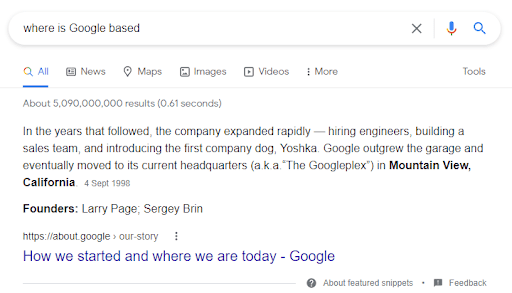
Fold
The ‘fold’ is where the page is cut off by the edge of the user’s monitor or browser window. Google prioritises the content ‘above the fold’ as it will be seen straight away by new visitors.
G
Google is a search engine founded by Larry Page and Sergey Brin in September 1998. Consisting of human-edited web directories, relying on web crawling technology and a complex algorithm to analyse hyperlinking patterns to rank websites. Google is the most-used search engine in nearly every country in the world.
Googlebot
Googlebot crawls web pages via links and reviews content, updates and feeds back what should be indexed or not. Google boys are also known as ‘spiders’ as they crawl the web.
Google Trends
Google Trends is a tool by Google that allows users to observe and compare the most popular terms related to an event or over a time period. This allows marketers to see when popular trends occur so they can predict the next ones.
Guest blog
Guest blogging is writing a piece of content for someone else’s website. Usually, a business with similar interests and niches in order to engage relevant audiences. Guest blogs usually contain a backlink which will increase traffic (See; traffic) and visibility.
Google Business Profile
Google Business Profile is a free tool by Google that allows businesses with a physical location or who serves a location area to manage their presence on Google Search and Google Maps. The tool allows businesses to add key information like categories, addresses, services, photos.
H
Header tag
Header tags, commonly known as heading tags represent the heading and subheadings on content. They are ranked from H1 – H6 and this bit of code tells the web page how to display the content.
HTML
Hypertext Markup Language (HTML) is a set of markup symbols and codes inserted into a file intended to display on a website. The code tells the browser how to display the web page’s words and images.
HTTPS
Hypertext Transfer Protocol Secure (HTTPS) is the secure version of the HTTP internet communication protocol that protects the integrity and confidentiality of data between the user’s computer and the site. Users expect a secure and private online experience when using a website.
I
Inbound link

An inbound link is a link coming from another site to your own website. Inbound links are really great for referring Traffic (See; Traffic) and receiving links from relevant, high authority websites will help boost your rankings.
Indexing
When a search engine discovers a new page, it tries to understand it. This is called Indexing. This means that the search engine analyses the content, images and videos on the page and stores them to rank them when a relevant search is made. Only indexed pages will rank in the search results.
Internal link
Internal links are links on your own website that you link together on the same domain. This allows traffic to move around your site and also passes authority to pages. It is important to use the last slug of URL in case you ever change your domain name so you do not create broken links.
IP Address
An IP address is a unique address that identifies a device on the internet or a local network. IP stands for “Internet Protocol’’. IP addresses are the identifier that allows information to be sent between devices on a network: they contain location information and make devices accessible for communication. An IP address is a string of numbers separated by periods. IP addresses are expressed as a set of four numbers. You can type ‘What’s my IP’ into Google to find out yours.
J
JavaScript
JavaScript is a programming language that allows you to implement complex features on web pages — every time a web page does more than just sit there and display static information for you to look at. For example, displaying timely content updates, interactive maps, animated 2D/3D graphics, scrolling video. HTML, CSS and JavaScript are layered together to create interactive web pages and content.
K
Keyword
Keywords are the words and phrases in your web content that make it possible for people to find your site via search engines. It is important to understand what your customer is searching for so you can include these keywords in your titles, content and meta descriptions (See; Meta Description).
Keyword Research
Keyword research is the process of finding and analysing search terms that people enter into search engines with the goal of using that data for a specific purpose. SEOs use tools to see how many times the keyword is searched for, how hard it is to rank and to find any associated keywords.#
Keyword Cannibalisation
Keyword cannibalisation means that you have multiple blog posts or articles on your site that can rank for the same search query in Google. This is because the topic they cover is too similar or because you optimised them for the same keyword. You can use software such as Semrush to identify any cannibalisation.
Knowledge Panel
Knowledge panels are information boxes that appear on Google when you search for entities (people, places, organisations, things) that are in the Knowledge Graph. They are meant to help you get a quick snapshot of information on a topic based on Google’s understanding of available content on the web.
There are different types of knowledge panels including People and Places, Organisations, Artists, and product descriptions.
L
Landing Page
A standalone web page, created specifically for a marketing or advertising campaign. It’s where a visitor “lands” after they click on a link in an email, or ads from Google, Bing, YouTube, Facebook, Instagram, Twitter, or similar places on the web.
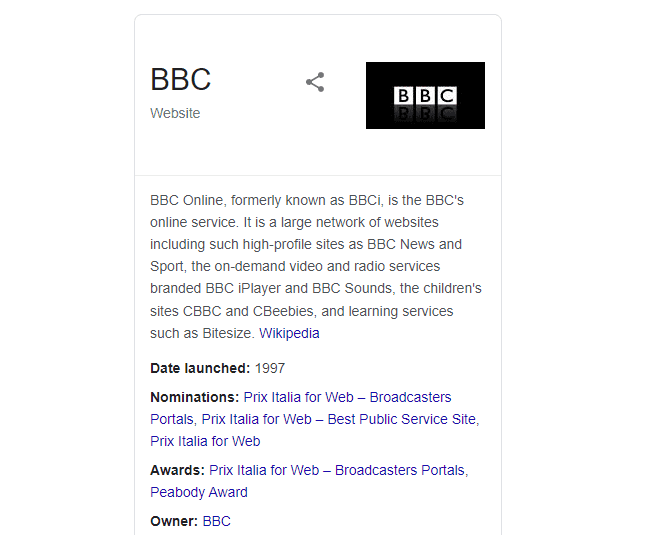
A knowledge panel about the BBC
Lead Magnet
A lead magnet is a term for a free item or service that is given away for the purpose of gathering contact details or subscriptions; for example, lead magnets can be free trials, eBooks, white papers or reports, newsletters, or free audits. Lead magnets are used to create sales leads.
Local SEO
Local SEO is a strategy that helps your business be more visible in local search results on Google. Any business that has a physical location or serves a geographic area can benefit from local SEO.
Long-Tail Keyword
Long-tail keywords are longer and more specific keyword phrases that visitors are more likely to use when they know exactly what they are looking for. They usually have low search volumes as they are so specific to the searcher. For example: Red rucksack with tassels.
Link Building
Link building is the process of getting other websites to link to pages on your own website. The purpose of link building is to boost the ‘authority’ of your pages in the eyes of Google, so that these pages rank higher and bring more search traffic.

Are your competitors consistently outranking you?
We can help you understand why and, more importantly, how to change it!
Get an SEO Review Now (Personal Video)
M
Meta Description
A meta description is the small blurb that appears underneath your website on the SERP that includes information about your page. It is designed to provide users with a brief summary of the content on your page so that users know if the page will answer their question.

Minification
Minification is a process using which you can optimise your website. It refers to the process of reducing the data in a resource or element without affecting how the resource renders or behaves on the browser at the user’s end.
Mobile-first indexing
Mobile-first indexing means Google predominantly uses the mobile version of the content for indexing and ranking. Historically, the index primarily used the desktop version of a page’s content when evaluating the relevance of a page to a user’s query.
N
Nofollow link
Nofollow links are links with a rel=”nofollow” HTML tag applied to them. The nofollow tag tells search engines to ignore that link. Because nofollow links do not pass PageRank they likely don’t impact search engine rankings.
NAP
NAP is an acronym for Name, Address, and Phone number. The NAP for your business needs to be correct and consistent when optimising your website and online presence for local search because Google values accurate information for its users. (see; Local SEO)
O
Off-Page Optimisation
Off-page Optimisation refers to actions taken outside of your own website to impact your rankings within search engine results pages (SERPs). Along with on-page SEO, these include several of the factors of basic SEO that help a site to rank.

An example of a business’ NAP on a directory
Optimising for off-site ranking factors involves improving search engine and user perception of a site’s popularity, relevance, trustworthiness, and authority. This is accomplished by other trustworthy places on the Internet (pages, sites, people, etc.) linking to or promoting your website.
On-Page Optimisation
On-site SEO (also known as on-page SEO) is the practice of optimising elements on a website in order to improve search engine ranking and visibility. This can involve optimising both the content and HTML source code of pages on a site.
Organic traffic
Organic traffic is those visitors that land on your website from unpaid sources, essentially free traffic.
Outbound Link
Rather than another site having a link to your website (see; backlink), outbound links are when you include a link to an external site on your blog page or website.
P
Pay Per Click
Pay per click (PPC) is an online advertising model in which an advertiser pays a fee every time an advertisement link is clicked on. Read how you can integrate SEO with PPC for better results.
Page Authority
Page authority, in search engine optimisation is the value a search engine assigns to a webpage. The higher the value, the more likely the search engine will return a webpage early in organic search results.
Pagination
Pagination is a sequence of pages which are connected and have similar content. For example, on eCommerce websites, category pages often implement pagination to break up a series of products into multiple pages. In blogs, pagination is used when a list of articles spans across multiple pages.
Q
Query Intent
Query intent is the reason behind the user’s search. There are four different types of search intent: informational, when a user is looking for information; navigational, when a user is looking for a specific website or location; transactional, when a user is looking to buy a specific product; and commercial, when a user is looking to find a product that fits their needs.
R
Ranking Factor
These are the factors which Google uses to decide which webpages will appear where on the search results. There are at least 200 of them and we don’t know the exact weighting each ranking factor is given so it’s best to try and cover as many of them as you can.
Redirect
Redirects are put in place to send users from one page of a website which no longer exists to another one. This means they do not land on an empty page, but one with content that is relevant to them.
Responsive Website
A responsive website automatically alters how it looks so that it is useable on all devices: computers, smartphones and tablets. This is done depending on the device a person is using at that time, adjusting the website for the different screen dimensions from the various devices.
Robots.txt
A robots.txt file tells search engine crawlers like Googlebot which urls it can and can’t access on your site. This is different from noindexing a site and should be used to stop your site being overloaded with requests when it is crawled.
Rich Snippet
These are the part of the search results which display more than the meta tags and URL of the page. They contain additional information and are often seen as things like infoboxes, carousels and reviews. They can add to the data provided about one of the organic links or appear above all of the links.
S
Schema Markup
This is code on your webpages that gives search engines the information your users want so that the search engines can display it on the results page as rich snippets.
Search Engine Results (SERPs)
These are the pages users see after they search for something on a search engine like Google. They present organic search results, also called the 10 blue links, rich snippets and adverts depending on the search query.
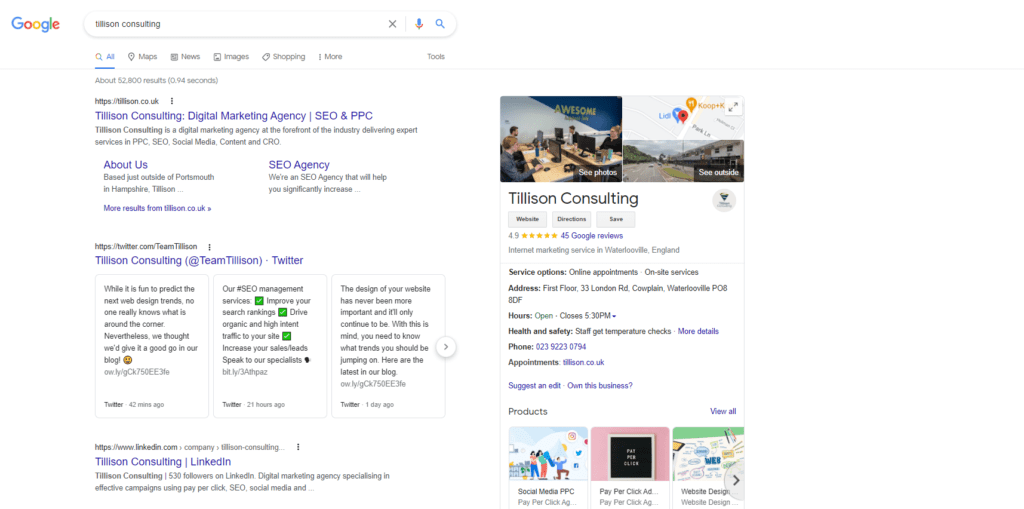
Sitemap
This file gives search engines information about what is on your site – the pages, video, images and other files. It also provides information about how all of these things are related, enabling search engines to crawl your site more efficiently.
T
Traffic
Traffic in terms of digital marketing includes everyone who visits your website from all sources. Organic traffic is the kind of traffic measured most by SEOs and is often seen as a good way of measuring the success of their strategy.
Technical SEO
This refers to improve the technical aspects of a website and is part of on-page SEO. Technical SEO includes structured data, sitemaps, security and website optimisation as well as a range of other factors which all contribute to your website’s technical quality.
U
User Experience
This refers to how users interact with and experience your website. If your website provides users with a good experience, it is more likely to rank highly in the search results, and includes things like loading time, font size and ease of navigation
Usability
This refers to how simple and easy users find using your website.
User Intent
The reason why a user is searching for a particular thing. See query intent.
UTM Tag
Properly called Urchin Traffic Monitor tags or codes, these snippets are attached to the end of URLs. They track where traffic that comes to your website has come from, whether that’s from social media like Twitter or Facebook, an ad or a different website entirely. They can also track the progress of specific campaigns or content.
Recent SEO Blog Posts
V
Vertical
These are specific industries or markets in a particular niche, like beauty or law. They can help narrow down how you market your products or services to ensure that only relevant traffic comes to your website.
Voice Search
When people ask an assistant like Alexa, Google, Siri or Cortana to search something on the internet for them. Voice search options also exist in certain browsers and are becoming more and more common as more people integrate smart home devices and assistants into their lives.
Video Marketing
This is when companies use video to tell users about their products or services, including product demonstrations and adverts. It has increased engagement and is becoming more and more common as a way of giving users more useful content.
W
WordPress
The world’s most popular content management system (CMS). It is free and simple to use. Around 40% of sites currently use WordPress to create and manage their content.
Website Navigation
How users find their way around your website, whether through a navigation bar or internal links between pages. Search engine bots will also use your navigation systems to find and index new pages.
X
XML Sitemap
A sitemap produced in a particular format (XML) which can be submitted to search engines to ensure efficient crawling. See also sitemap.
Y
YouTube Optimisation
The steps taken to optimise video content for YouTube, to ensure that they are presented for the right queries and audience. Embedding well-optimised videos on your website can keep users who are on your site engaged and linking to your site in the video’s description can help bring traffic to it.
Yahoo!
Yahoo! is a search engine and web portal with services including e-mail, news and an advertising platform. It was established by Jerry Yang and David Filo in 1994 and was the most popular website in the world in 2000.

Are your competitors consistently outranking you?
We can help you understand why and, more importantly, how to change it!
Get an SEO Review Now (Personal Video)
Yoast SEO
A plugin that helps with the optimisation of individual pages on your website. It can automate things like the creation of meta tags and help improve both the optimisation and readability of your pages.
Z
Zero-Click
Searches that end without any of the results being offered, organic or paid, being clicked. The number of zero-click searches has been increasing in recent years, possibly due to the increase in rich snippets in the search results.
So there you have it…
A complete list of all the SEO terms you should be familiar with in 2022. Remember, we’re experts in SEO but also offer services such as paid advertising and conversion rate optimisation so be sure to get in touch to see how we can deliver excellent results for you!
